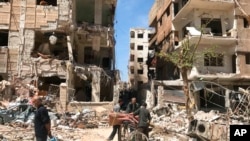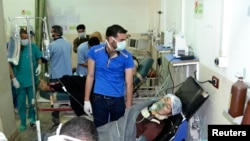On January 27, the Organization for the Prohibition of Chemical Weapons (OPCW) released a report implicating Syrian government forces in an April 2018 chemical weapons attack on the city of Douma.
The report found “reasonable grounds to identify Syrian Arab Air Forces” as the perpetrators of “toxic” chlorine gas attacks on the then rebel-controlled Damascus suburb that killed 43 people and affected dozens.
Syria’s Foreign Ministry rejected the report’s conclusions.
“The [Syrian Foreign Ministry] statement said that the report lacks scientific and objective evidence, and no sane person or specialist can reach such misleading conclusions,” Syria’s state-run SANA news agency summarized the foreign ministry as saying.
“Those who prepared this report neglected the objective observations raised by State parties, experts, academics and former OPCW inspectors, known for their expertise and knowledge.”
That is false.
The OPCW reviewed over 19,000 files, obtained and assessed 66 witness statements, and considered data related to 70 samples. It also followed up on “lines of inquiry” suggested by Syria and other state parties.
Adhering to “best practices,” the OPCW reached its conclusions after collecting, scrutinizing and corroborating all the available information gathered throughout the course of its nearly two-year investigation.
The inspection team was not granted access to the attack sites, even though Damascus was obligated to do so under the Chemical Weapons Convention.
Still, the OPCW had access to samples collected 14-18 days after the attack, along with other evidence.
The OPCW said it reviewed “the analytical data” of samples collected from a pair of residential buildings where a Syrian government Mi-8/17 helicopter dropped two yellow cylinders.
Those samples included “dry and wet wipes of surfaces, concrete debris, wood, fabric, plastic material, paint flakes, and metal and biomedical samples of victims.”
A subset of those samples was analyzed at two OPCW-designated laboratories. Another laboratory, a forensic institute, and other specialists and experts were further consulted, “to ensure the independence” of the OPCW’s analysis.
That, along with witness statements, and other evidence and sources, proved “sufficient to reach solid conclusions, to the requisite degree of certainty,” on how the attacks were carried out, the OPCW said.
The OPCW said the analysis of the samples “revealed the presence of chlorine gas markers whose formation and specific position at both sites can solely be explained by the release of high concentrations of chlorine gas from the cylinder.”
Those high chlorine gas concentrations allowed the OPCW to rule out claims the incident may have been staged using household bleach products or pesticides, or did not happen at all.
Syria, and its ally Russia, have repeatedly claimed the attack was “staged.”
Polygraph.info has previously documented some of the methods used to promote such claims.
The OPCW team said no “reliable information” had been identified, “including satellite imagery, video or photographic footage, or intercepts,” backing up allegations that armed groups or other entities staged the attacks.
The report said it would have been extremely difficult, “if not impossible,” to mimic the spread of chlorine consistent with the release from the cylinders found at both locations.
The OPCW also said it would have been impossible to predict which samples the inspectors collected, and from where.
None of the samples collected from either location “displayed a result that was inconsistent with the hypothesis that chlorine gas was released from the cylinders found at both locations.”
Meantime, the claims that the OPCW ignored the “objective observations” of outside parties, specifically former OPCW inspectors, is false.
Polygraph.info has previously covered the case of two former OPCW employees, whom Russia and Syrian regime supporters call “whistleblowers.”
An independent OPCW probe found those two individuals were not senior inspectors who played a “central role” in the Douma investigation. In a strongly worded statement, the OPCW director earlier said the two former employees “could not accept that their views were not backed by evidence,” adding their conclusions were “erroneous, uninformed, and wrong.”
One of those employees had argued that the metal cylinders were placed at both locations rather than dropped from a helicopter, as eyewitnesses claimed.
The OPCW found that scenario “incompatible with the totality of the information it gathered,” with its inspectors noting that the damage to the cylinders was consistent with being dropped from “a considerable altitude.”
They further said it was “highly implausible" the cylinders were manually carried to the scenes of the attack, adding they had found “ no evidence” that had happened. Each of the cylinders was over one meter long, with a body and base diameter exceeding 30 centimeters, and a capacity of between 100 and 120 liters.
Other skeptics denied the victims showed signs of chlorine poisoning.
That is contradicted by both witness testimony , and imagery of the treatment of victims, which was assessed by several specialists and an independent toxicologist.
Since the Syrian civil war erupted in 2011, government forces have credibly been implicated in hundreds of chemical weapons attacks.
They include the August 13, 2013, sarin gas attack on Ghouta, which killed more than 1,400 people.







